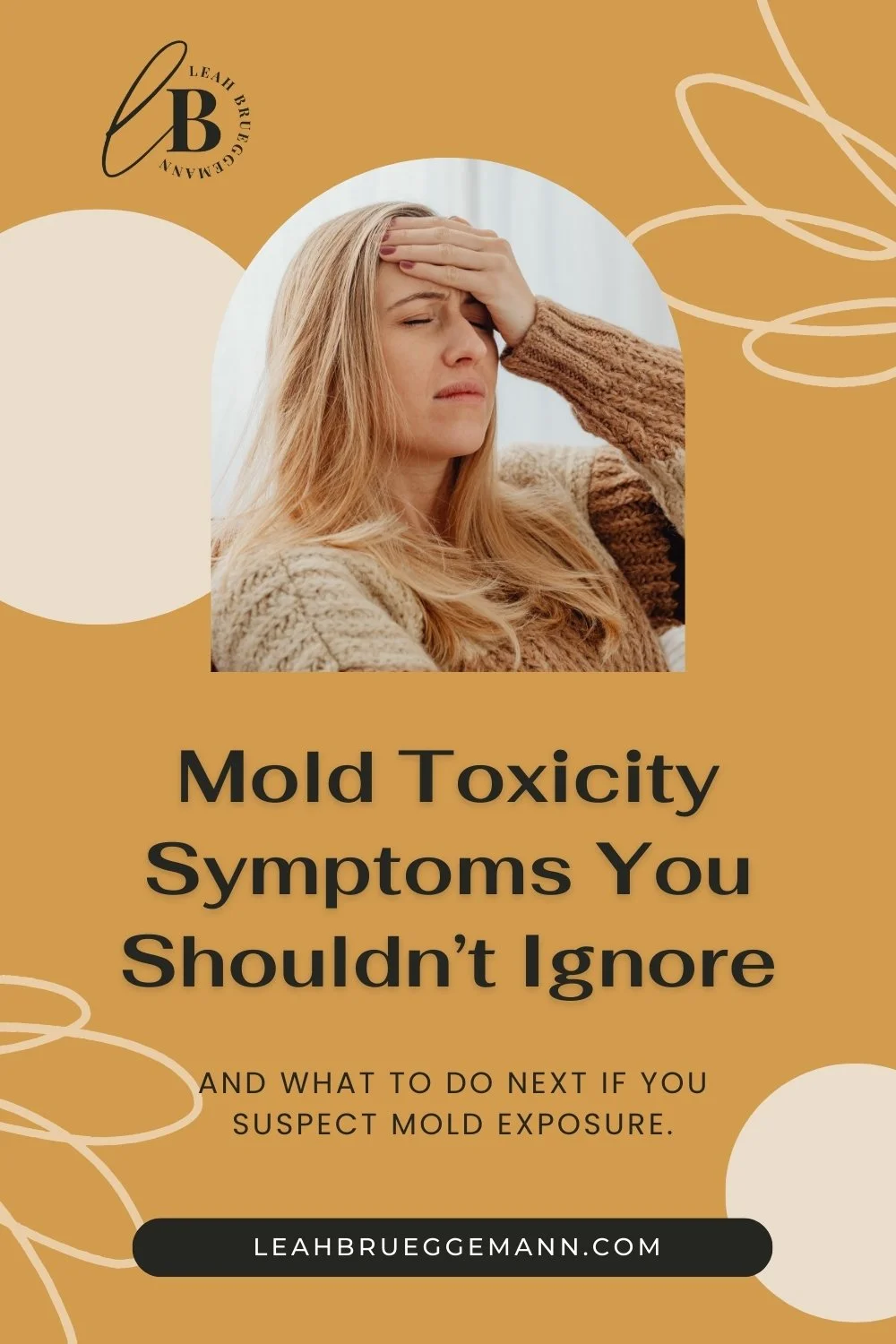Mold Toxicity Symptoms You Shouldn’t Ignore
Last year I started experiencing some weird symptoms, which led me down the rabbit hole of mold toxicity, testing, remediation, and all the nitty-gritty details of resolving mold toxicity symptoms. Now, fair warning, I'm sharing this from my Leah perspective, but let me be crystal clear: mold is no joke, and what I'm about to share is my genuine journey.
I've noticed mold has become a bit of a buzzword lately. Don't get me wrong; I'm not downplaying the struggles of those dealing with mold illness – it's a very real and significant issue. But it's not a one-size-fits-all scenario. So, I want to navigate through the hype while shedding light on the genuine challenges.
My Experience with Mold Toxicity
Before diving in, let me share a bit about our home situation. I've never undergone a genetic test specifically for mold, but it's always been on my radar due to my younger brother's chromosomal deficiency which affects his liver's ability to detox mold. So, while I hadn't personally faced any issues, mold has been on my radar, including with clients.
So, after a massive rainstorm, our basement had a little leak due to the tilted patio. My husband, the hero, noticed and took action right away. We dried it up, got a dehumidifier, and I ordered an Immunolytics mold test as a proactive measure.
Fast forward four weeks post-leak, and I started experiencing odd symptoms. First, a stuffy nose after a sauna session, then the kids got stuffy noses too. Soon, I struggled with shortness of breath, joint pain, and an overall feeling of aging overnight. Confused, I immediately thought I must just be out of shape. It wasn't until I recalled the mold test sitting on my desk (in the basement!) that I connected the dots.
So, I sent in the sample, and when the results came back, the mold count was way higher than safety levels. Panic set in. Our basement, with its air vents, had spread those mycotoxins throughout the house. I decided to move my workspace, and within days, my breathing improved.
Realizing the severity, I talked it over with my husband, and we concluded that professional remediation was a must. Luckily, it wasn't a long-term leak, so major reconstruction wasn't necessary. We swiftly took action, tested with Immunolodics, and confirmed the need for remediation. Easy, quick, and relatively affordable!
But before we get into the ins and outs of mold remediation, let’s look at how mold toxicity affects our health and what kind of symptoms may indicate a mold problem.
Mold Toxcity Symptoms
Mold exposure can trigger a variety of symptoms, and understanding these manifestations is key to recognizing the impact of mold toxicity. Here's a closer look at how these symptoms might play out:
Respiratory Issues: Mold can irritate the respiratory system, leading to symptoms such as coughing, wheezing, and shortness of breath. Individuals exposed to mold may experience persistent respiratory discomfort, mimicking the effects of allergies or respiratory infections.
Skin Problems: Mold exposure can manifest in skin-related issues, including rashes, itchiness, or redness. These symptoms might be localized to specific areas or affect larger portions of the body.
Fatigue and Joint Pain: Mold toxicity can contribute to feelings of fatigue and joint pain. Individuals might find themselves constantly tired, even after sufficient rest, and experience discomfort or pain in their joints.
Cravings for Sweets: Mold's influence on the body's biochemistry can lead to unusual cravings, particularly for sweets. This can be a puzzling experience, as individuals may suddenly develop a desire for sugary foods without an apparent cause.
Brain Fog: A common complaint after mold exposure is brain fog, characterized by a feeling of mental cloudiness or confusion. Concentrating on tasks, memory recall, and overall cognitive function may be impaired during episodes of brain fog.
Increased Sensitivity to EMF: Mold exposure might heighten sensitivity to electromagnetic fields (EMF). This could result in individuals feeling more affected or disrupted by electronic devices, Wi-Fi signals, or other sources of electromagnetic radiation.
Digestive Issues: Some individuals may experience digestive symptoms, such as abdominal discomfort, bloating, or changes in bowel habits, as a consequence of mold exposure.
Headaches: Mold toxicity can contribute to headaches or migraines. These headaches may vary in intensity and duration, and they can be a recurring issue for individuals exposed to mold.
Mold is often hidden in plain sight, making it a potential culprit behind various health issues. So, if you find yourself grappling with several of these symptoms without a clear explanation (like I was!) toxic mold exposure could be the missing puzzle piece.
What to do if you Suspect Mold Toxicity
First and foremost, trust your instincts. If you're struggling with multiple unexplained symptoms, from respiratory issues to fatigue, mold exposure could be the culprit. Let’s walk through the steps to identify and remediate your mold problem.
Step 1: Symptom Recognition
Acknowledge the symptoms—coughing, sneezing, skin problems, brain fog, and beyond. Mold toxicity can manifest in diverse ways, affecting various bodily systems. If your health seems like a puzzle with missing pieces, consider mold as a potential piece of the puzzle.
Step 2: Investigate Living Spaces
Become a detective in your living space. Mold loves hiding in plain sight, infiltrating walls, ceilings, and damp corners. Conduct a thorough visual inspection, checking for any signs of water damage, leaks, or musty odors. Mold thrives in moisture-rich environments, so pay special attention to bathrooms, basements, and kitchens.
Step 3: Professional Testing
While visual inspections are a good start, professional testing is the gold standard. Consider tests like the Organic Acid Test (OAT), mycotoxin tests, and the GI map. These tests serve as your health detectives, uncovering hidden mold threats that might elude the naked eye.
Step 4: Remediation
If mold is detected, opt for professional remediation over DIY cleaning methods. Mold is resilient, and incomplete removal can lead to regrowth. Professionals employ comprehensive methods, ensuring thorough elimination and preventing future infestations. We worked with Pure Maintenance, who use an innovative dry fog method to rid your home of mold.
Step 5: Air Quality Improvement
Invest in air purifiers to cleanse your living space. Mold spores can linger in the air, contributing to ongoing health issues. Additionally, consider a brief hiatus from Wi-Fi to create a healthier indoor environment.
Step 6: Dietary Adjustments and Liver Support
Adopt a diet that avoids mold-containing foods. Mold toxins can wreak havoc on your body, and a liver-friendly diet can aid detoxification. Support your liver—your body's detoxification organ—through supplements and nourishing foods.
Being Proactive
I really can’t recommend Dr. Jill Christa's book, "Break the Mold” enough. As a naturopathic doctor, she has so much insightful perspective that can guide you on this journey. If you're unsure where to start or just want to dive deeper into the topic of mold exposure, it's a fantastic read.
Remember, experiencing these symptoms doesn't automatically point to mold. There are various potential culprits. However, if you've ruled out other possibilities and the puzzle pieces align, it might be time to consider mold as a factor.
Mold toxicity seems to be a buzzword these days, and while mold illness is certainly no joke, I firmly believe not everyone is dealing with mold issues. Regardless, taking care of your body's foundation is key. So, explore, stay informed, and prioritize your well-being!
Switch & Ditch Guide
Non-Toxic Product Swaps
Simple product swaps and recommendations to help you remove toxins and chemicals from your life! This guide will support you in choosing less toxic options when it's time to purchase your everyday products again.
Additional Resources
The recommendations presented in this blog are not a substitute for medical advice from a qualified doctor. Before making any changes to your diet and lifestyle, please consult with your health care provider.
Some of these links contain affiliate links.





